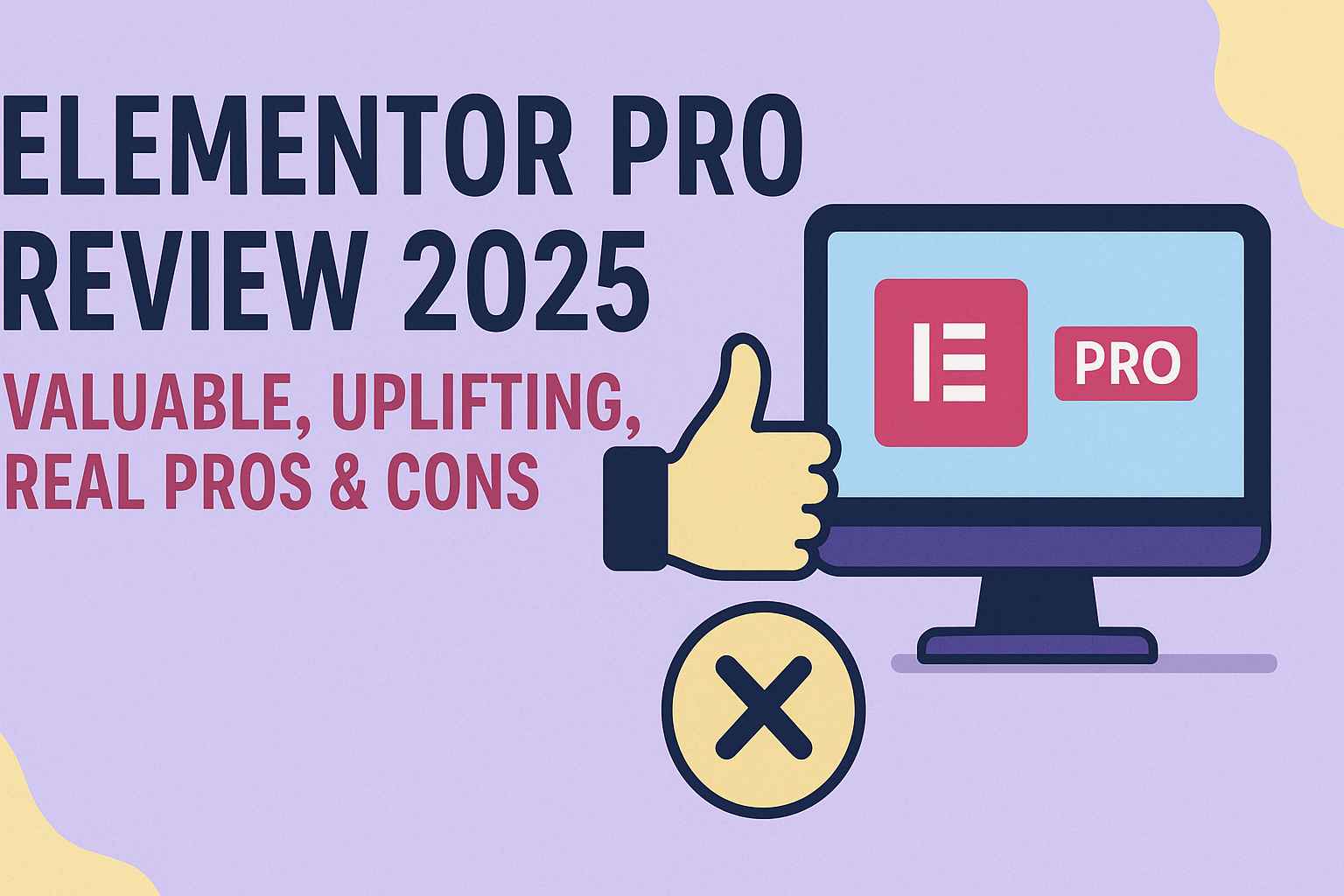If you’ve ever tried building a website on WordPress, you probably know the feeling: staring at a blank page, wishing you could just drag, drop, and see the magic happen. Elementor Pro claims to make that a reality, offering an intuitive, code-free way to create beautiful websites. But does it truly deliver, and is it the right fit for your site? In this detailed Elementor Pro review, you’ll find an honest exploration of Elementor Pro’s key features, a transparent look at its pros and cons (including a handy table), insights into pricing, and a look at how it compares to alternatives. Whether you’re a beginner, a web designer, or just weighing your plugin options, this article is crafted to answer your questions.
What is Elementor Pro?
Elementor Pro is a premium plugin that transforms WordPress into a visual, drag-and-drop website builder. Building upon the free version of Elementor, Pro unlocks advanced widgets, theme editing, dynamic templates, and more. Since its launch in 2016, Elementor (over 5 million active installs according to WordPress.org) has been a go-to for users who want powerful design control without tinkering with code.
Key Features of Elementor Pro
- Visual Drag-and-Drop Editor: Instantly see design changes as you make them.
- Theme Builder: Customize headers, footers, archives, single post, WooCommerce pages, and more.
- Over 90 Widgets: From basic buttons to advanced sliders, forms, pricing tables, and integrations.
- Pop-up Builder: Craft stylish pop-ups triggered by actions or timed events.
- Global Widgets & Design Settings: Manage site-wide elements and styling efficiently.
- Integration with Marketing Tools: Connect with Mailchimp, Zapier, HubSpot, and others.
- Responsive Design Controls: Fine-tune layouts for desktop, tablet, and mobile.
“Elementor Pro’s biggest pitch is visual freedom—without code headaches.”
Diving Deeper: Hands-on Experience with Elementor Pro
If you’re like me and have tried your hand at various WordPress themes and builders over the years, you’ll know some leave you restricted. What first struck me with Elementor Pro was its sense of creative freedom balanced with surprising ease.
Getting Started: First Impressions
Installing Elementor Pro is straightforward—upload the plugin, activate your license, and it integrates seamlessly with your WordPress dashboard. The interface feels modern and user-friendly, with clear labels and intuitive drag-and-drop zones.
Designing Pages and Templates
Elementor Pro lets you create pages visually. As you drag widgets (think: image, text, testimonial) onto your canvas, you see the live preview. Unlike older builders, you don’t keep guessing at code, then refreshing your browser. The Theme Builder stands out—allowing control over templates for posts, pages, headers, and even WooCommerce shops. Reusable “global widgets” are a lifesaver when managing recurring site elements.
Speed, Stability, and Flexibility
From my use, Elementor Pro rarely bogged down my site. With proper hosting and a well-coded theme, pages loaded fast—even with complex layouts. Updates have steadily improved performance and compatibility with the WordPress ecosystem.
Elementor Pro: Pros and Cons
| Pros | Cons |
|---|---|
| Easier visual editing—no coding skills required | Can feel overwhelming for absolute beginners |
| Comprehensive widget library | Occasional conflicts with certain themes/plugins |
| Advanced theme and pop-up builder | Pro features locked behind paywall |
| Good documentation and community support | Can increase page size if not optimized |
| Responsive design controls | Features can be excessive for simple sites |
| Active updates and improvement | Yearly subscription (no lifetime license) |
| Integration with marketing/CRM tools | Some advanced modules (e.g., custom code) still need coding skills |
“Elementor Pro strikes a balance between power and usability, though it’s not entirely beginner-proof.”
Pricing: How Much Does Elementor Pro Cost?
Elementor Pro uses an annual subscription model, with prices based on the number of sites you plan to use it on. Here’s a clear breakdown:
| Plan Name | Sites Included | Features | Price* (Yearly) |
|---|---|---|---|
| Essential | 1 | All Pro features, updates, support | $60 and $84 |
| Advanced | 3 | All features, updates, priority support | $99 |
| Expert | 25 | Same as above, for agencies/freelancers | $204 |
| Agency | 1000 | For large-scale agencies, white-label option | $399 |
*As of August 2025. Always double-check the latest prices at the official Elementor pricing page.
Additional costs to keep in mind:
- Your WordPress hosting fees.
- Potential premium addons you might want for extra widgets or integration.
“Annual pricing ensures regular updates, but can be a con if you’re looking for a one-off purchase.”
Where Elementor Pro Shines—and Falls Short
Perfect Use Cases
- Freelancers and Agencies: If you build several client sites that need custom layouts, Elementor Pro pays for itself in saved time and professional polish.
- Small Business Owners: Want to tweak your site without calling a developer? Elementor gives you control within arm’s reach.
- Bloggers and eCommerce: Its Theme Builder and WooCommerce integration are robust enough for content sites and stores alike.
Limitations
If you only need a simple blog or a brochure site, Elementor Pro’s power can be overkill. Sometimes, simpler themes or even the free Elementor version will do. Also, very complex, performance-driven sites (think: news publications with custom features) may instead call for custom themes or advanced, lightweight frameworks.
Is Elementor Pro Worth It? Comparing With Alternatives
Many readers weigh Elementor Pro against options like Beaver Builder, Divi, or the Block Editor (Gutenberg). What sets Elementor Pro apart is the combination of power, visual flexibility, and community momentum.
Notable differences:
- Beaver Builder: Slightly lighter, but less visually expansive out-of-the-box.
- Divi: Lifetime pricing, feature-rich, but with a steeper learning curve and heavier shortcodes.
- Gutenberg: Native, free, but less visually refined (for now).
If you’re hungry for visual design and site-wide control—and don’t mind the subscription Elementor charges—Elementor Pro holds a strong lead.
Frequently Asked Questions
Can you switch away from Elementor Pro later?
Yes, but designs built with Elementor-specific widgets and layouts won’t look the same if you deactivate it. That’s something to consider if long-term flexibility is a top priority.
How is plugin support and updates?
Elementor has a responsive support team (especially for Pro users) and an active community. Documentation is thorough, and updates arrive frequently.
Are there new features on the horizon?
Elementor often teases upcoming features. For 2025, there’s a big emphasis on speed optimization and collaboration tools—check their official blog for the latest.
Conclusion: Should You Invest in Elementor Pro?
Elementor Pro isn’t perfect—but it’s impressively close for anyone wanting a visual, flexible site builder in the WordPress sphere. Its intuitive interface, powerful widget library, and site-wide templating make it a top choice for professionals and tinkerers alike. Though the pricing may not suit hobbyists or those okay with limited free features, the value shines for anyone regularly building or updating websites.
“After years of assembling WordPress sites the old-fashioned way, Elementor Pro almost feels like cheating—in the best sense. For many, it’s a true game changer.”
Thinking about trying it? If you value design freedom without the coding hassle, and especially if you need pro-level features for business or client sites, Elementor Pro is well worth considering.
Want more WordPress insights? Explore our guide on choosing the best hosting for Elementor sites and more related reviews!
Have you used Elementor Pro? Share your thoughts or questions in the comments below!





